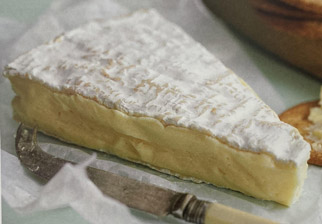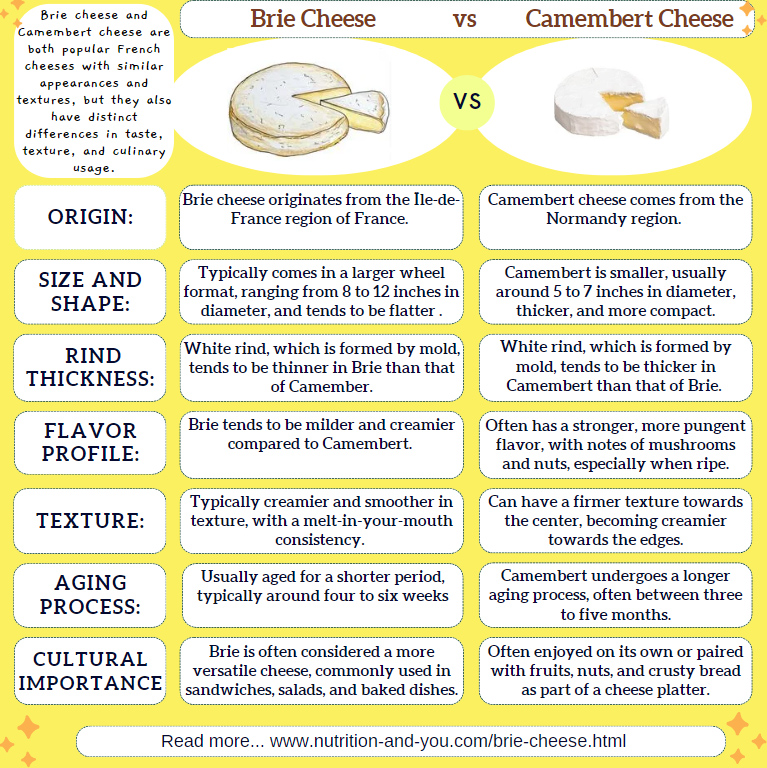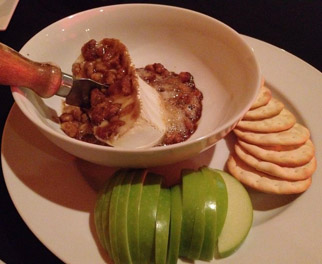Brie Cheese Nutrition facts
Brie cheese is one of the most popular dairy products of French origin. This soft, white cheese with a bloomy rind is produced from culturing cow's milk. One of the early cheeses produced, it was first recorded in the 8th century.
Brie cheese is produced in many countries of Europe, but the best produce comes from the Brie region in Northern France. It is pale in color and tastes creamy but also tangy and fresh.
 |
| Fresh Brie cheese. |
This cow's- milk cheese is soft with an off-white rind and made in the form of a large, flat 14-inch wheel. Brie receives a very modest maturation period of about 4-6 weeks before it is released for the markets.
Types of Brie cheeses
Brie de-Meaux utilizes rennet to form the curd. It is smooth, creamy, and not quite running. Traditionally it is prepared around Meaux town in France using unpasteurized milk.
Brie-de-Melun relies primarily on the action of the bacteria converting the milk lactose to lactic acid. However, a small amount of rennet is allowed to coagulate over a long period of time.
Here, curds are ladled into molds without being cut. Edges beneath the rind soften first while the center remains chalky. It has a stronger and slightly saltier flavor. Traditionally, it is prepared around Melun town in France using unpasteurized milk.
Camembert cheese is another popular French cheese with similar appearances and textures but is smaller, thicker, and more compact. It has a distinctively thicker rind and stronger flavor than brie.
See the differences between Brie cheese and Camembert in an infographic:

|
Production of Brie cheese:
Production of good quality Brie cheese is a meticulous process that demands skill, patience, and time.
Equipment required include vat (or large bowl) with lid, slotted spoon, large knife, cheese molds, cheese draining mat or tray with holes, thermometer, and dorm refrigerator for aging.
Ingredients: Fresh or store-bought whole milk- pasteurized or unpasteurized, mesophilic starter culture, Penicillium candidum mold spores, rennet, and cheese salt.
Brie cheese is prepared from cow's milk. Both microbial and fungal activities by culture and mold spores influence the uniqueness of Brie cheese aroma, taste, and texture of the rind.
The initial step is to curdle the milk. Heat 2 gallons of milk to 88-90 F in a large container or vat. Then, sprinkle 1 packet of direct set mesophilic starter culture and 1/8 tsp of Penicillium candidum.
Let the culture begin doing its work for about 60 minutes. During this period, lactose is converted to lactic acid. After about 60 minutes, add liquid rennet to milk, stirring thoroughly.
Next, allow the curd to sit quietly for 90 minutes while the culture continues to work and the rennet coagulates the curd. Cut the curd vertically and allow it to sit for 5 minutes.
Then, slowly transfer (scoop) the curd with a large slotted spoon by taking thin layers (1/2") from the curd mass and gently placing them into the molds. Traditionally made the whole cow's milk brie cheese uses a 14-inch mold.
Fill the molds slowly, layer by layer to allow the curds to settle briefly and whey to drain before the next addition.
Next, allow the curds to settle into a solid mass and continue draining. Maintain the draining space temperature at 68-74F to obtain a fine end product.
Turn the cheese in the molds several times during the first 24 hours to ensure its complete dryness.
After 24 hours, remove the cheese from molds and salt all sides at a rate of 2% of the weight of the wheel (approximately ½ tablespoonful for a half-gallon wheel of cheese). Allow to air dry at room temperature for another couple of days, flipping once or twice a day.
Age the cheese in a container at 50 degrees F for 2 weeks, flipping every couple of days.
At 2 weeks, wrap in cheese paper/wax paper and age at 50 degrees for another 2-4 more weeks depending on the size of the wheel and the ripeness you want. Then store it in a regular refrigerator. It will continue to ripen in the refrigerator but more slowly due to the colder temperature.
Health benefits of Brie cheese
Brie cheese is a high-calorie dairy product; 3.5 oz (100 g) holds 334 calories and 27.7 g of fats. Nonetheless, it is one of the finest sources of almost all nutrients including vitamin D and B12.
It is a very good source of dietary calcium and phosphorous; and together with vitamin D, consumption of brie cheese plays an important role in bone strengthening and growth, especially in children.
Brie provides high-quality protein that is rich in all essential amino acids needed for growth and development and helps stay healthy. 3.5 oz (100 g) Brie contains 20.8 g or about 37% of recommended daily intake of protein.
It contains minimal amount of lactose (0-2%) making it one of the dietary source for those with lactose intolerance. Almost all the naturally occurring lactose within cow milk is converted into more easily digestible lactic acid during the production of brie cheese.
Brie, being a dairy product, is free of gluten. In gluten-sensitive (Celiac disease) persons, it is another important source of gluten free food items rich in protein, minerals and vitamins.
During the ripening process, all the major milk constituents such as lactose, milk lipids, and milk proteins, undergo biochemical changes into more easily digestible and health-benefiting products.
Also, certain volatile flavoring chemical compounds originate while aging as by-products like in Brie methyl ketones, and corresponding secondary alcohols, 2-octanone, 3-octanone, 1-octen-3-ol, 1,5-octadien-3-ol, 1,5-octadien-3-one, 2-methylisoborneol, and 2-Mehthoxy-3-isopropylpyrazine, which give characteristic earthy and fruity flavor to it.
Brie cheese s a very good source of fat soluble vitamins, especially vitamin A. 100g of aged Brie contains 592 IU (20% of RDI) of this vitamin.
Brie is a very concentrated source of minerals, especially calcium (18% of RDI), phosphorus (24% of RDI), zinc (21% of RDI), iron (6%) and magnesium (5%) per 3.5 oz (100 g).
| Principle | Nutrient Value | Percent of RDA |
|---|---|---|
| Energy | 334 Kcal | 16.7% |
| Carbohydrates | 0.45 g | <1% |
| Protein | 20.8 g | 37% |
| Total Fat | 27.7 g | 138.5% |
| Dietary Fiber | 0 g | 0% |
| Vitamins | ||
| Folates | 65 μg | 14% |
| Niacin | 0.380 mg | 2.4% |
| Pyridoxine | 0.235 mg | 18% |
| Riboflavin | 0.52 mg | 40% |
| Thiamin | 0.070 mg | 6% |
| Vitamin-A | 592 IU | 20% |
| Vitamin-C | 0 mg | 0% |
| Vitamin-D | 20 IU | 3.3% |
| Vitamin-E | 0.24 mg | 1.5% |
| Vitamin-K | 2.3 µg | 2% |
| Electrolytes | ||
| Sodium | 321 mg | 21% |
| Potassium | 120 mg | 2.55% |
| Minerals | ||
| Calcium | 184 mg | 18.4% |
| Copper | 0.019 mg | 2% |
| Iron | 0.50 mg | 6% |
| Magnesium | 20 mg | 5% |
| Manganese | 0.034 mg | 1.5% |
| Phosphorus | 188 mg | 24% |
| Zinc | 2.38 mg | 21.5% |
Buying guide for Brie cheese
Fresh, aged brie cheese is readily available in groceries, and supermarkets all around the year in the US. Look for soft-ripened Brie that is creamy in texture with a pleasant fruity aroma.
Cheese experts judge the quality of Brie by having less than 54% moisture and more than 23% milk fat. It is as having less than 54% moisture and more than 23% milkfat.
In the stores, Brie comes in many different versions like blue-veined Bries, as well as herbs, spices ingredients added to them.
A high-quality Brie features a regular wheel shape, thin rind, and white with some red streaking due to red organisms. Its body and consistency have a characteristically light creamy color, very little or no openness in texture, supple, smooth, and not runny at consumption temperature. It should have a pleasant, characteristic, rather mild with a fruity aroma.
Avoid those with Irregular shapes, slimy rinds, very moist, and numerous spots. Also, look for if too discolored, has much openness, is very firm or runny, is granular, layered, and has a flavor that is over acid, bitter, very salty, metallic, pungent, very ammoniacal, and soapy taste.
Storing
Being a gentle dairy product, Brie cheese is highly perishable and may only last one week.
At home, lightly wrap brie cheese with wax, or parchment paper to prevent mold development or drying. It also allows it to continue to naturally age and breathe, so the flavor remains fresh.
Culinary uses of Brie cheese
Brie is one of the most versatile soft cheeses that can be experimented varieties of recipes.
You could eat it plain, sprinkle it on your salad, or add in mouth-watering confectioneries and dishes.
To prepare, take it out of your refrigerator and leave it out at room temperature for 1 hour. It turns nice and creamy so you get the most out of its flavor. Warming it briefly in the microwave makes it gooey on the inside.
Brie is traditionally cut into small wedges and eaten with plain toast crackers. You can also pair it with all sorts of toppings and drinks. Use melted brie in many different dishes to enjoy its unique, gooey deliciousness.
Cut brie into triangular-shaped slices. Its rind is edible, along with the rest of the cheese.
Here are some serving tips
 |
| Baked brie & fruits, crackers. Courtesy: Phil Denton |
Melted Brie cheese goes well on a burger, with bacon or seafood sandwiches.
As an appetizer, pair the cheese with sweet fruit or nuts to complement its flavors.
Brie en croute is a classic French pastry dish, where a small wheel of brie cheese is wrapped in a puff phyllo pastry and baked until it is golden brown.
Prepare Crepe Lorraine with- spinach, brie cheese, and ham.
Bake it in a pastry, casserole, or top on pizza or flatbreads.
Prepare Brie cheese gratin recipe with potatoes and caramelized onions.
Safety profile
Brie cheese is among high salt and saturated fats containing dairy products. Eat it in moderation.
Aged cheeses, including Brie, are high in tyramine content, and if a person on Mono-amine oxidase inhibitors (MAOI's) medication like Phenelzine (Nardil) consumes cheeses, he may develop a medical emergency known as "hypertensive (high blood pressure) crisis" which have symptoms like severe headache, sweating, nosebleeds, fast heartbeat, chest pain, blurring of vision, shortness of breath, and confusion, and should seek immediate medical attention. Also, they need to continue following a low-tyramine diet for a few weeks after stopping these medications.
National Headache Foundation categorizes brie in the "avoid" food group consumption.
(Medical Disclaimer)Source: Mayo clinic: MAOI's and diet.
Also read ≻≻-
≻≻- Cheddar cheese nutrition facts.
≻≻- Ricotta cheese nutrition facts.
≻≻-Back to Dairy products from Brie cheese nutrition facts.
≻≻-Back to Home page.
Further Resources:
USDA National Nutrient Database. (opens in new window).
Brie/Camembert-Cheese making made easy. (opens in new window).
National Headache Foundation-low tyramine headache diet. --pdf.